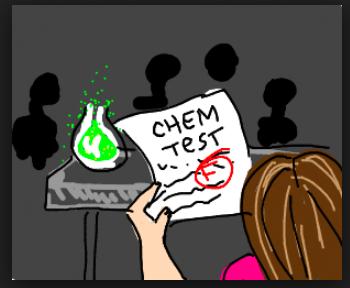It's a good thing that the New York Times has the resources to hire someone to cover for its "chemical expert" Nick Kristof, who is qualified to write about toxicity because he is... a lawyer.
Nonetheless, Kristof believes that he is knowledgeable enough to write about chemistry and toxicology, something he does fairly often. He is clearly not (See Why I Don't Write About Pottery From The Ming Dynasty And Nick Kristoff Shouldn't Write About Science).
Kristof's replacement last week was Niraj Chokshi, who sports a B.A. in psychology, and Chokshi stepped up like a trooper. Otherwise, we might have been deprived of a recent article on a really lame scare about chemicals in crayons. It is not clear which of the two is less qualified to be writing about toxicology.
As the "newspaper of record," you'd think that the Times might be able to afford, let's say, a scientist to write about science, but the paper has shown no inclination to do so. Instead, we get "the newspaper of the broken record" - devout amateurs who simply parrot the words of other know-nothings, like the Natural Resource Defense Council,
Chokshi doesn't help his credibility much by going to just about possibly the worst source for information of any kind, especially science - the United States Public Interest Research Group. Rather than wade through libraries of evidence to support this, I think I'll just rely on American Council president Hank Campbell. He knows firsthand:
"I worked there in the late 1980s and they were wrong on every single issue - except a bottle bill instead of mandatory government recycling. They were right on that then, and they'd still be right today; government recycling is a fiasco. But aside from that, if there was an environmental fad they created a campaign about it. From nuclear energy to acid rain, they claimed we were doomed unless people gave us money."
American Council president Hank Campbell, August 9, 2018
Given the background of the reporter and the quality of his source, one might expect that the science wouldn't be so hot. One would be correct. It's the same old song - claiming that the presence of a given chemical tells us anything about its health hazard. This fallacy is commonly used but it is dead wrong, especially when the discussion does not include dose or exposure.
In the article Chokshi speaks with Dev Gowda, one of the authors of US PIRG's new "woe is me" publication entitled "Safer School Supplies: Shopping Guide." (Gowda has a B.S. in psychology and a law degree. Are you picking up a theme here?). Here are some more absurd claims that are found in the Times article:
"United States Public Interest Research Group Education Fund, which had an independent laboratory test 27 back-to-school products. Four tested positive for dangerous chemicals."
There ya go. The usual - kids, dangerous chemicals, tested positive. Straight from the NRDC playbook. "Tested positive" means that the chemical is detectable, but says nothing about how much is there. With advances in analytical methods over the past few decades, minuscule quantities of chemicals are being "discovered" just about everywhere. The chemicals have always been present but in the past, the instrumentation was not sensitive enough to detect them. Now it is. Are these products now more dangerous because we now know about the chemicals in them? Really silly.
“It’s insane for us to be finding asbestos in kids’ products, whether it’s technically legal or not, and parents shouldn’t have to worry about this in 2018."
What's really insane is the thought that parents have to read this tripe and worrying about nothing because we do not know if Gowda is talking about one pound of asbestos or one molecule:
"Of the crayons tested, one, a green Playskool crayon, tested positive for trace amounts of tremolite, a form of asbestos."
Whatever that means.

The Green Crayon From Hell. Original Image: HalloweenCostumes.com
"One of those compounds, benzene, is a known carcinogen and was found in a package of six magnetic markers purchased on Amazon and produced by The Board Dudes, a brand owned by Mattel."
Yes, benzene is a carcinogen. But if you don't want to be exposed to any of it stop breathing. Gasoline can contain a maximum of 0.62% benzene, some of which gets into the air. Is this more or less than what was found in one package of The Board Dudes? Who knows?
"In another set of tests, the public interest organization examined three three-ring binders for phthalates, a group of chemicals added to plastics to make them flexible, some of which may affect human reproduction or development."
No, they don't. (See American Academy Of Pediatrics Goes Crybaby Over 'Scary' Chemicals)
"Since the scientific evidence strongly suggests that risks to humans are low, phthalate regulations that have been enacted are unlikely to lead to any marked improvement in public health."
Michael A. Kamrin, Phthalate Risks, Phthalate Regulation, and Public Health: A Review, Journal of Toxicology and Environmental Health, Part B: Critical Reviews, 12:2, 157-174 (2009) DOI: 10.1080/10937400902729226
In another horrific development:
"Four markers were sent to the laboratory, and two dry-erase ones tested positive for a group of compounds often found in petroleum products and known as B.T.E.X.: benzene, toluene, ethylbenzene and xylene."
Uh oh. More nasty chemicals. But...
"... and none [were present] at levels considered worrying by toxicologists, according to the report.
What a relief.
So, this article, which probably terrified mothers all over the country is a big fat nothing. It is a psychology major interviewing another psychology major with a law degree who represents US PIRG - a group with not a single scientist on its staff page.
All the news that's fit to print?
Hardly. Just a bunch of ignorant chemophobic nonsense.
NOTES:
(1) NRDC recently used Kristof (!) as its sole source of science in an embarrassingly ridiculous Facebook video, which equated the pesticide chlorpyrifos with the Nazi nerve gas Sarin (See NRDC's Hitler-Pesticide Video Worthy Of Joseph Goebbels).




